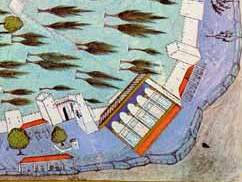 W
WThe Topkapı Palace, or the Seraglio, is a large museum in the east of the Fatih district of Istanbul in Turkey. In the 15th and 16th centuries it served as the main residence and administrative headquarters of the Ottoman sultans.
 W
WThe Ahmet Hamdi Tanpınar Literature Museum Library is a literary museum and archive dedicated to Turkish literature and named after the Turkish novelist and essayist Ahmet Hamdi Tanpınar (1901–1962). Located in Istanbul, Turkey, the museum was established by the Ministry of Culture and Tourism and opened on November 12, 2011.
 W
WThe Basketmakers' Kiosk, also known as Sepetçiler Palace, named after the Sepetçi Roma (basketmakers), is a former Ottoman pleasure palace located on the southern shore of Golden Horn's mouth at Sarayburnu in the neighborhood of Sirkeci in Istanbul, Turkey.
 W
WEnderûn was the term used in the Ottoman Empire to designate the "Interior Service" of the Imperial Court, concerned with the private service of the Ottoman Sultans, as opposed to the state-administrative "Exterior Service" (Birûn). Its name derives from the location of the Sultan's apartments in the inner courts of the Topkapi Palace; its head was the Kapi Agha.
 W
WThe Enderun School was a palace school and boarding school mostly for Princes of the court and the Janissaries of the Ottoman Empire, which primarily recruited students via devşirme, a system of the Islamization of Christian children for serving the Ottoman government in bureaucratic, managerial, and Janissary military positions. Over the centuries, the Enderun School was fairly successful in creating Ottoman statesmen by drawing among the empire's various ethnic groups and giving them a common Muslim education. The school was run by the "Inner Service" (Enderûn) of the Ottoman palace and had both academic and military purposes. The graduates were expected to devote themselves to government service and be free of links to lower social groups.
 W
WGülhane Park is a historical urban park in the Eminönü district of Istanbul, Turkey; it is adjacent to and on the grounds of the Topkapı Palace. The south entrance of the park sports one of the larger gates of the palace. It is the oldest and one of the most expansive public parks in Istanbul.
 W
WThe Hrvoje's Missal is a 15th-century missal written in Glagolitic alphabet.
 W
WHagia Irene or Hagia Eirene, sometimes known also as Saint Irene, is an Eastern Orthodox church located in the outer courtyard of Topkapı Palace in Istanbul. It is one of the few churches in Istanbul that has not been converted into a mosque, as it was used as an arsenal for storing weapons until the 19th century. The Hagia Irene today operates as a museum and concert hall.
 W
WKafes, literally "the cage", was the part of the Imperial Harem of the Ottoman Palace where possible successors to the throne were kept under a form of house-arrest and constant surveillance by the palace guards.
 W
WThe Marble Kiosk was a structure directly located at the banks of the Bosphorus of Topkapı Palace in Istanbul, and served as a pleasure building for the Ottoman Padishah. It was located next to the Cannon Gate, both structures are today lost.
 W
WThe Imperial Harem of the Ottoman Empire was the Ottoman sultan's harem – composed of the wives, servants, female relatives and the sultan's concubines – occupying a secluded portion (seraglio) of the Ottoman imperial household. This institution played an important social function within the Ottoman court, and wielded considerable political authority in Ottoman affairs, especially during the long period known as the Sultanate of Women. Multiple historians claim that the sultan was frequently lobbied by harem members of different ethnic or religious backgrounds to influence the geography of the Ottoman wars of conquest. The utmost authority in the Imperial Harem, the valide sultan, ruled over the other women in the household; the consorts of the sultan were normally of slave origin, and thus were also his mother, the valide sultan.
 W
WThe Palace Basilica is a ruined basilica in the Second Courtyard of Topkapı Palace in Istanbul, Turkey.
 W
WThe Pearl Kiosk was a mansion directly located at the banks of the Bosphorus and served as a pleasure building for the Ottoman sultan. It was built in 1590 by the grand vizier Koca Sinan Pasha.
 W
WThe Piri Reis map is a world map compiled in 1513 by the Ottoman admiral and cartographer Piri Reis. Approximately one third of the map survives; it shows the western coasts of Europe and North Africa and the coast of Brazil with reasonable accuracy. Various Atlantic islands, including the Azores and Canary Islands, are depicted, as is the mythical island of Antillia and possibly Japan.
 W
WThe Procession Kiosk is a 16th-century historical building on the outer walls of the Gülhane Park next to Topkapı Palace in Istanbul, Turkey. It was used by the Ottoman sultans to receive the salute of processing janissary as well as a pleasure locale. The building is situated across the Sublime Porte.
 W
WThe Islamic Sacred Relics, also known as the Holy Relics, known collectively as the Sacred Trust, consist of religious pieces sent to the Ottoman Sultans between the 16th century to the late 19th century.
 W
WThe Tiled Kiosk is a pavilion set within the outer walls of Topkapı Palace and dates from 1472 as shown on the tile inscript above the main entrance. It was built by the Ottoman sultan Mehmed II as a pleasure palace or kiosk. It is located in the most outer parts of the palace, next to Gülhane Park. It was also called Glazed Kiosk.
 W
WThe Topkapi manuscript or Topkapi Quran is an early manuscript of the Quran dated to the late 1st century / early 2nd century AH
 W
WThe Topkapı Scroll is a Timurid dynasty pattern scroll in the collection of the Topkapı Palace museum.